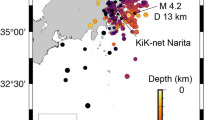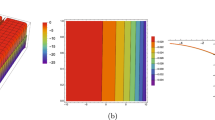Abstract
In this paper a direct coupling analysis method (DCAM) of hydroelastic responses of a very large floating structures (VLFS) in complicated geographical environment is presented. In this method the three-dimensional hydroelasticity theory of floating bodies is combined with the shallow water wave theory, to allow for proper description of the influence of uneven seabed and sheltering effect of islands on the hydroelastic responses of a VLFS deployed near island and reefs in shallow sea. This method and the numerical procedures were verified and validated by comparison between the predictions and the model test results of a 3-module VLFS and an 8-module VLFS in two simulated shallow sea regions with different seabed topography.
Similar content being viewed by others
References
MOB Project Team. Mobile offshore base science and technology program final report [R]. Naval Facilities Engineering Service Center, 2000.
Ohmatsu S. Overview: Research on wave loading and responses of VLFS [J]. Marine Structures. 2005, 18(2): 149–168.
Wang Z. J., Li R. P., Shu Z. A study on hydroelastic response of box-type very large floating structures [J]. China Ocean Engineering, 2001, 15(3): 345–354.
Cui W. C., Wu Y. S., Li R. P. Recent researches on dynamic performances of very large floating structures [J]. Journal of Ship Mechanics, 2001, 5(1): 73–81(In Chinese).
Cui W. C., Yang J. M., Wu Y. S. et al. Hyroelasticity of very large floating structures [M]. Shanghai, China: Shanghai Jiao Tong University Press, 2007(in Chinese).
Wu Y. S. Hydroelasticity of floating bodies [D]. Doctoral Thesis, London, UK: Brunel University, 1984.
Tian C., Ni X. Y., Ding J. Theoretical study on hydro-elastic responses of very large floating structures near islands and reefs [C]. Proceedings of the 33rd International Conference on Ocean, Offshore and Arctic Engineering, San Francisco, USA, 2014.
Tian C., Ni X. Y., Liu X. L. Hydroelastic investigation on floating body near islands and reefs [C]. Proceedings of the 11th International Conference on Hydrodynamics, Singapore, 2014.
Yang P., Gu X. K., Tian C. et al. Motion responses of floating structures near small islands [C]. Proceedings of the 34rd International Conference on Ocean, Offshore and Arctic Engineering, St. John’s, Canada, 2015.
Yang P., Liu X. L., Ding J. et al. Hydroelastic responses of a VLFS in the waves influenced by complicated geographic environment [C]. The 7th International Conference on Hydroelasticity in Marine Technology, Split, Croatia, 2015.
Wu Y. S., Ding J., Tian C. Numerical analysis and model tests of a three-module VLFS deployed near islands and reefs [J]. Journal of Ocean Engineering and Marine Energy, 2018, 4(2): 111–122.
Zhang X. T., Lu D., Gao Y. et al. A time domain discrete-module-beam-bending-based hydroelasticity method for the transient response of very large floating structures under unsteady external loads [J]. Ocean Engineering, 2018, 164: 332–349.
Takami T., Matsui S., Oka M. et al. A numerical simulation method for predicting global and local hydroelastic response of a ship based on CFD and FEA coupling [J]. Marine Structures, 2018, 59: 368–386.
Ding J., Tian C., Wu Y. S. et al. A simplified method to estimate the hydroelastic responses of VLFS in the inhomogeneous waves [J]. Ocean Engineering, 2019, 172: 434–445.
Lin Q., Lu D. Q., Yeung R. W. Hydroelastic response of a circular plate in waves on a two-layer fluid of finite depth [J]. China Ocean Engineering, 2014, 28(5): 671–686.
Meng Q. R., Lu D. Q. Wave-induced hydrodynamic responses of a rigid body connected with elastic plates floating on a two-layer fluid [J]. Journal of Fluids and Structures, 2017, 68: 295–309.
Kohout A. L., Meylan M. H. Wave scattering by multiple floating elastic plates with spring or hinged boundary conditions [J]. Marine Structures, 2009, 22(4): 712–729.
Ding J., Tian C., Wu Y. S. et al. Hydroelastic analysis and model tests of a single module VLFS deployed near islands and reefs [J]. Ocean Engineering, 2017, 144: 224–234.
Wei G. E., Kirby J. T., Grilli S. T. et al. A fully nonlinear Boussinesq model for surface waves. Part I. Highly nonlinear unsteady waves [J]. Journal of Fluid Mechanics, 1995, 294: 71–92.
Ding J. A direct coupling analysis method of hydroelasttic responses of VLFS in complicated ocean environment [D]. Doctoral Thesis, Wuxi, China: China Ship Scientific Research Center, 2018(in Chinese).
Ni X. Y. Coupling analysis of flexible floating structure and mooring system in time domain [D]. Doctoral Thesis, Wuxi, China: China Ship Scientific Research Center, 2016(in Chinese).
Wu Y. S., Zou M. S., Tian C. et al. Theory and applications of coupled fluid-structure interactions of ships in waves and ocean acoustic environment [J]. Journal of Hydrodynamics, 2016, 28(6): 923–936.
Wu Y. S., Ding J., Li Z. W. et al. Hydroelastic responses of VLFS deployed near islands and reefs [C]. Proceedins of the 36th International Conference on Ocean, Offshore, and Arctic Engineering, Trondheim, Norway, 2017.
Acknowledgment
The authors also gratefully acknowledge the contributions to this paper from Xue-kang Gu, Xiao-ming Cheng, Ye Lu, Ming-gang Tang, Yong-lin Ye and Jia-jun Hu of CSSRC.
Author information
Authors and Affiliations
Corresponding author
Additional information
Project supported by the National Key Research and Development Program of China (Grant No. 2017YFB0202701), the Ministry of Science and Technology with the Research Project (Grant No. 2013CB36102) and the Ministry of Industry and Information Technology with the research project (Grant No. [2016]22).
Biography: Jun Ding (1986-), Male, Ph. D., Senior Engineer
Rights and permissions
About this article
Cite this article
Ding, J., Wu, Ys., Zhou, Y. et al. A direct coupling analysis method of hydroelastic responses of VLFS in complicated ocean geographical environment. J Hydrodyn 31, 582–593 (2019). https://doi.org/10.1007/s42241-019-0047-8
Received:
Revised:
Accepted:
Published:
Issue Date:
DOI: https://doi.org/10.1007/s42241-019-0047-8




